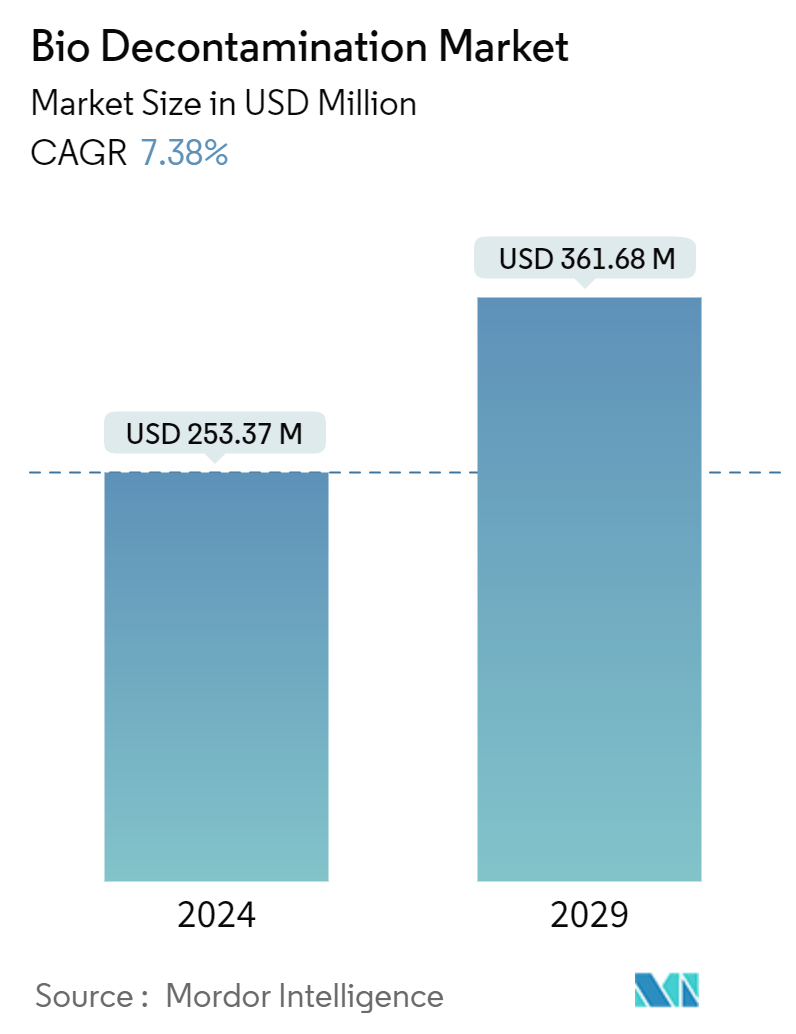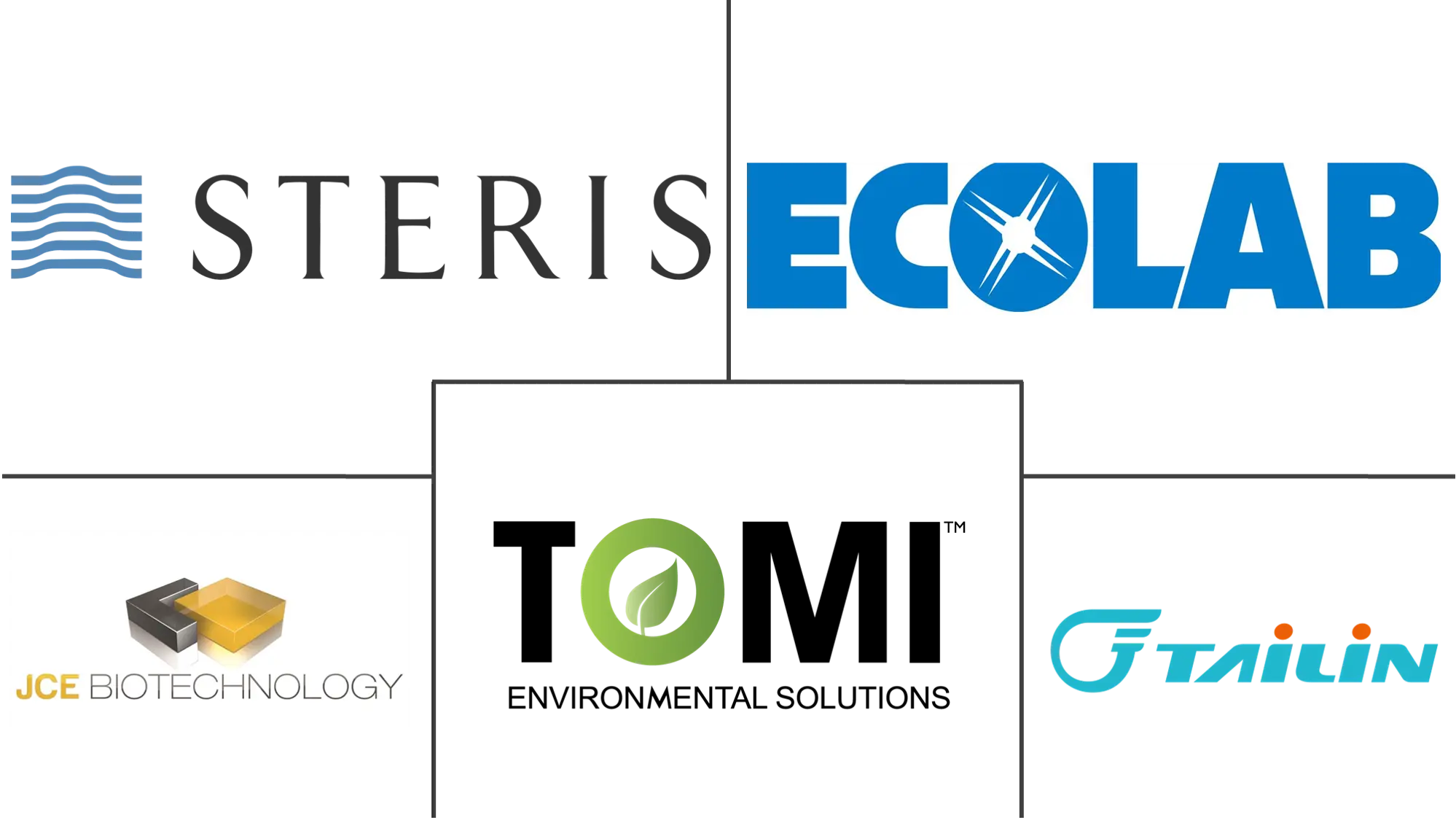Market Size of Bio Decontamination Industry

| Study Period | 2019 - 2029 |
| Market Size (2024) | USD 253.37 Million |
| Market Size (2029) | USD 361.68 Million |
| CAGR (2024 - 2029) | 7.38 % |
| Fastest Growing Market | Asia-Pacific |
| Largest Market | North America |
Major Players
*Disclaimer: Major Players sorted in no particular order |
Bio Decontamination Market Analysis
The Bio Decontamination Market size is estimated at USD 253.37 million in 2024, and is expected to reach USD 361.68 million by 2029, growing at a CAGR of 7.38% during the forecast period (2024-2029).
- The bio decontamination market plays a pivotal role in safeguarding industries where hygiene and safety are paramount, such as healthcare, pharmaceuticals, and biotechnology. As regulatory standards become increasingly stringent and awareness of infection control rises, the demand for effective bio decontamination methods has surged. This market spans a comprehensive range of products and services, including bio decontamination equipment, services, and consumables, all designed to prevent contamination in environments requiring strict cleanliness.
- The growth of this market is driven by several key factors. Foremost among these is the rising incidence of hospital-acquired infections (HAIs), which necessitates enhanced bio decontamination protocols. Additionally, the increasing number of surgical procedures and the growing trend of outsourcing bio decontamination services are significant contributors to market expansion. Healthcare facilities, pharmaceutical companies, and research institutions are increasingly adopting advanced bio decontamination systems to ensure sterile environments and comply with industry regulations.
- Key players in the bio decontamination industry, such as Ecolab, Steris plc, and Tomi Environmental Solutions Inc., offer diverse bio decontamination solutions tailored to specific applications. These solutions include hydrogen peroxide vapor systems, chlorine dioxide systems, and other advanced technologies that deliver high decontamination efficacy, catering to the needs of various sectors.
Hospital-Acquired Infections: A Growing Concern for Healthcare Facilities
- Rising HAI Incidences: Hospital-acquired infections (HAIs) are a growing concern in the healthcare industry, prompting a greater focus on effective bio decontamination solutions. HAIs lead to increased patient morbidity and healthcare costs, driving healthcare facilities to invest in advanced decontamination methods to mitigate infection risks.
- Infection Control Protocols: The enforcement of strict infection control protocols has heightened the demand for bio decontamination equipment and services. Hospitals increasingly rely on automated bio decontamination systems to ensure comprehensive sterilization of critical areas such as operating rooms and intensive care units.
- Government Regulations: Government mandates on hygiene standards are fueling the adoption of bio decontamination technologies. These regulations are particularly stringent in healthcare settings, where the need for sterile environments is critical to patient safety.
- Outsourcing Services: The growing awareness of HAIs has led healthcare facilities to outsource bio decontamination services to specialized companies. This trend enables hospitals to access the latest technologies and expertise, ensuring compliance with the highest cleanliness standards.
Increasing Number of Surgical Procedures: Driving Demand for Advanced Bio Decontamination Solutions
- Global Surgical Growth: The increasing number of surgical procedures worldwide, particularly in regions with aging populations, is driving the demand for bio decontamination equipment and services. Sterile environments in operating rooms and post-operative care units are crucial to preventing infections and ensuring positive patient outcomes.
- Investment in Technologies: Hospitals and surgical centers are investing in cutting-edge bio decontamination technologies to maintain high sterility levels. Automated systems that quickly and effectively decontaminate large areas are becoming essential tools for enhancing operational efficiency.
- Minimally Invasive Surgery: The growing popularity of minimally invasive and robotic surgeries is also boosting the need for advanced bio decontamination solutions. These procedures require ultra-sterile environments to prevent infections that could jeopardize patient safety and surgical success.
- Evolving Surgical Technology: As surgical technology evolves, the bio decontamination market is expected to grow, driven by innovations that offer faster, more efficient, and more effective decontamination processes.
Bio Decontamination Industry Segmentation
As per the scope of the report, bio-decontamination involves using biological decontamination agents to clean the surroundings. The main motive of bio-decontamination is to check the spread of microorganisms and other hazardous contaminants that may risk the health of humans and animals.
The bio decontamination market is segmented by product and service, agent type, end user, and geography. By product and service, the market is segmented as equipment, services, and consumables. By agent type, the market is segmented as hydrogen peroxide, chlorine dioxide, peracetic acid, and nitrogen dioxide. By end user, the market is segmented as pharmaceutical and medical device manufacturing companies, life sciences and biotechnology research organizations, and hospitals and healthcare facilities. By geography, the market is segmented into North America, Europe, Asia-Pacific, and the rest of the World. The report offers the market size in value terms in USD for all the above-mentioned segments.
| By Product and Service | |
| Equipment | |
| Services | |
| Consumables |
| By Agent Type | |
| Hydrogen Peroxide | |
| Chlorine Dioxide | |
| Peracetic Acid | |
| Nitrogen Dioxide |
| By End User | |
| Pharmaceutical and Medical Device Manufacturing Companies | |
| Life Sciences and Biotechnology Research Organizations | |
| Hospitals and Healthcare Facilities |
| Geography | ||||||||
| ||||||||
| ||||||||
| ||||||||
| Rest of the World |
Bio Decontamination Market Size Summary
The bio-decontamination market is experiencing significant growth, driven by the increasing incidence of hospital-acquired infections (HAIs) and the rising number of surgical procedures. The COVID-19 pandemic has further accelerated this demand, as the necessity for sterilization and decontamination became paramount to prevent the spread of infections within healthcare settings. The market is characterized by the growing use of bio-decontamination agents, such as hydrogen peroxide, which are effective in reducing the transmission of infections like ventilator-associated pneumonia and Clostridium difficile infections. The adoption of advanced decontamination technologies, including vaporized hydrogen peroxide systems, is also contributing to market expansion, as these systems offer efficient and automated solutions for maintaining hygiene in healthcare facilities.
Geographically, North America holds a significant share of the global bio-decontamination market, supported by a robust healthcare sector and a high prevalence of HAIs. The region's growing geriatric population and increased surgical procedures further drive the demand for bio-decontamination equipment and services. Market players are actively engaging in strategies such as partnerships, expansions, and new product launches to strengthen their market position. The market remains partially fragmented, with key players like Steris PLC, Ecolab, and Tomi Environmental Solutions Inc. leading the way. Despite budgetary constraints in healthcare facilities posing challenges, the overall outlook for the bio-decontamination market remains positive, with continued growth anticipated over the forecast period.
Bio Decontamination Market Size - Table of Contents
-
1. MARKET DYNAMICS
-
1.1 Market Overview
-
1.2 Market Drivers
-
1.2.1 Rising Incidence of Hospital-acquired Infections
-
1.2.2 Increasing Number of Surgical Procedures
-
1.2.3 Increasing Outsourcing of Bio-decontamination Services
-
-
1.3 Market Restraints
-
1.3.1 Budgetary Constraints in Healthcare Facilities
-
-
1.4 Porter's Five Forces Analysis
-
1.4.1 Threat of New Entrants
-
1.4.2 Bargaining Power of Buyers/Consumers
-
1.4.3 Bargaining Power of Suppliers
-
1.4.4 Threat of Substitute Products
-
1.4.5 Intensity of Competitive Rivalry
-
-
-
2. MARKET SEGMENTATION (Market Size by Value - USD)
-
2.1 By Product and Service
-
2.1.1 Equipment
-
2.1.2 Services
-
2.1.3 Consumables
-
-
2.2 By Agent Type
-
2.2.1 Hydrogen Peroxide
-
2.2.2 Chlorine Dioxide
-
2.2.3 Peracetic Acid
-
2.2.4 Nitrogen Dioxide
-
-
2.3 By End User
-
2.3.1 Pharmaceutical and Medical Device Manufacturing Companies
-
2.3.2 Life Sciences and Biotechnology Research Organizations
-
2.3.3 Hospitals and Healthcare Facilities
-
-
2.4 Geography
-
2.4.1 North America
-
2.4.1.1 United States
-
2.4.1.2 Canada
-
2.4.1.3 Mexico
-
-
2.4.2 Europe
-
2.4.2.1 Germany
-
2.4.2.2 United Kingdom
-
2.4.2.3 France
-
2.4.2.4 Italy
-
2.4.2.5 Spain
-
2.4.2.6 Rest of Europe
-
-
2.4.3 Asia-Pacific
-
2.4.3.1 China
-
2.4.3.2 Japan
-
2.4.3.3 India
-
2.4.3.4 Australia
-
2.4.3.5 South Korea
-
2.4.3.6 Rest of Asia-Pacific
-
-
2.4.4 Rest of the World
-
-
Bio Decontamination Market Size FAQs
How big is the Bio Decontamination Market?
The Bio Decontamination Market size is expected to reach USD 253.37 million in 2024 and grow at a CAGR of 7.38% to reach USD 361.68 million by 2029.
What is the current Bio Decontamination Market size?
In 2024, the Bio Decontamination Market size is expected to reach USD 253.37 million.

